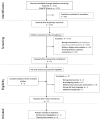Effect of Cycling Cadence on Neuromuscular Function: A Systematic Review of Acute and Chronic Alterations
- PMID: 34360206
- PMCID: PMC8345521
- DOI: 10.3390/ijerph18157912
Effect of Cycling Cadence on Neuromuscular Function: A Systematic Review of Acute and Chronic Alterations
Abstract
There is a wide range of cadence available to cyclists to produce power, yet they choose to pedal across a narrow one. While neuromuscular alterations during a pedaling bout at non-preferred cadences were previously reviewed, modifications subsequent to one fatiguing session or training intervention have not been focused on. We performed a systematic literature search of PubMed and Web of Science up to the end of 2020. Thirteen relevant articles were identified, among which eleven focused on fatigability and two on training intervention. Cadences were mainly defined as "low" and "high" compared with a range of freely chosen cadences for given power output. However, the heterogeneity of selected cadences, neuromuscular assessment methodology, and selected population makes the comparison between the studies complicated. Even though cycling at a high cadence and high intensity impaired more neuromuscular function and performance than low-cadence cycling, it remains unclear if cycling cadence plays a role in the onset of fatigue. Research concerning the effect of training at non-preferred cadences on neuromuscular adaptation allows us to encourage the use of various training stimuli but not to say whether a range of cadences favors subsequent neuromuscular performance.
Keywords: EMG; fatigability; pedaling frequency; pedaling rate; strength.
Conflict of interest statement
The authors declare no conflict of interest.
Figures
References
-
- Ansley L., Cangley P. Determinants of “optimal” cadence during cycling. Eur. J. Sport Sci. 2009;9:61–85. doi: 10.1080/17461390802684325. - DOI
Publication types
MeSH terms
LinkOut - more resources
Full Text Sources




